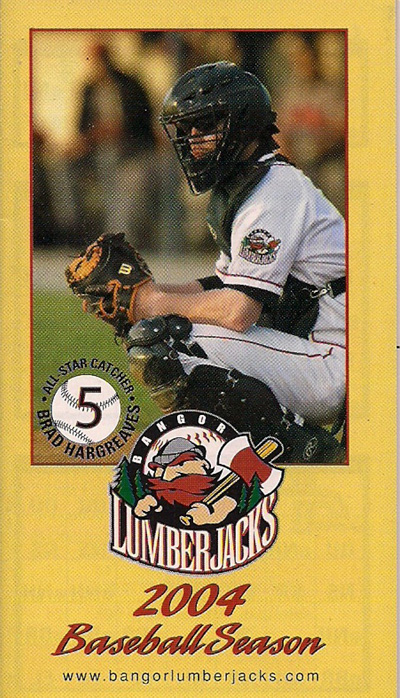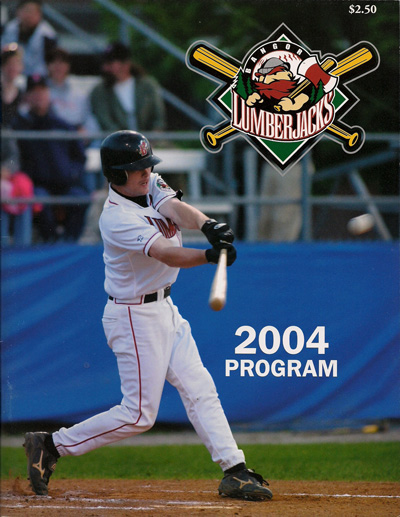Tombstone
Born: 2003 – The Adirondack Lumberjacks relocate to Bangor, ME
Folded: April 28, 20051Jordan, Glenn. “Lumberjacks cease operations”. The Press Herald (Portland, ME). April 29, 2005
First Game: May 22, 2003 (W 2-1 @ Allentown Ambassadors)
Last Game: September 12, 2004 (L 15-3 vs. New Jersey Jackals)
Northeast League Championships: None
Stadia
2003: Larry Mahaney Diamond (3,000)22003 Northeast League Media Guide
Dimensions (2003): LF 330′, CF 400′, RF 330′
2004: John Winkin Baseball Complex
Opened: 2004
2004: Mansfield Stadium
Ownership & Affiliation
Owner: Chip Hutchins
Major League Affiliation: Independent
Attendance
Background
The Bangor Lumberjacks were the second of two failed attempts to establish low-level professional baseball in (or at least “near”) Bangor, Maine during the independent baseball boom of the 1990’s and early 21st century. Both the Lumberjacks and their predecessor, the Bangor Blue Ox (1996-1997), had a brand identity closely connected to Paul Bunyan folklore. Bangor claims to be the birthplace of the mythic logger and has a gargantuan statue of the woodsman in a downtown park.
In the case of the Lumberjacks, the Bunyan connection was a little more coincidental. The independent club already existed for eight years in Glens Falls, New York under the ‘Adirondack Lumberjacks’ name before relocating to Maine. Bangor businessman Charles M. “Chip” Hutchins bought the Northeast League ball club from Charles Jacey for a reported $575,000 in October 2002. In the move to Bangor, Hutchins retained the Lumberjacks moniker, along with Adirondack’s field manager Kash Beauchamp and Charles Jacey’s son Curt as the team’s General Manager.

Kash
Beauchamp was something of an independent baseball legend. The son of former Major League journeyman Jim Beauchamp, Kash was the first overall selection in the 1982 Major League Baseball amateur draft. He never made it to the Majors during a 12-year minor league career. When the independent baseball resurgence began with the formation of the Northern League in the summer of 1993, Beauchamp was one of the first players to sign, latching on with the Rochester (MN) Aces. He hit .367 and earned league MVP honors that summer. Beauchamp later signed with the Cincinnati Reds and joined their farm system, helping to legitimize the upstart Northern League as a place where Major League organizations would scout and sign talent.
Stadium issues played a key role in the destiny of both of Bangor’s baseball efforts. The Blue Ox played for two seasons at the University of Maine’s Mahaney Diamond, ten miles up the road in Orono while hoping to get City Council approval of a $2 million bond for a new ballpark in Bangor. When that effort failed by a single vote in 1997, the team closed its doors.
The Wink
Unlike the Blue Ox, Hutchins could count on a new stadium – albeit a no-frills one – for his Lumberjacks. The John Winkin Baseball Complex at Bangor’s Husson College would feature 3,000 seats for baseball and a new FieldTurf surface. The ballpark had a low-seven figure price tag, footed in collaboration by long-time University of Maine Baseball Coach John Winkin, local philanthropist Harold Alfond, and the Bangor City Council. However, the approval process dragged out until the fall of 2003. Like the Blue Ox before them, the Lumberjacks would play their first season at Mahaney Diamond in Orono.

Debut Season
For the 2003 season, Beauchamp assembled an iconoclastic band of pro baseball castoffs. Jeff Sparks was a screwballer with an unconventional delivery who already made the unlikely leap from indy ball to the Major Leagues once, pitching in two dozen games for the Tampa Bay Devil Rays in 1999-2000. Now he was back in independent ball, still pursuing the dream. 31-year old Santiago Henry was in his 12th season of minor league baseball – but his first as a pitcher. Lorenzo De La Cruz was another guy entering his second decade in the minors. A holdover from Adirondack, De La Cruz hit .367 and won Northern League Player-of-the-Year honors in 2002.
The team fared poorly in its first season in Maine, finishing 42-49 or the worst record in the Northeast League’s North Division. At the turnstiles, the ‘Jacks sold 400 season tickets sales and averaged just 1,089 fans per game at their temporary home in Orono.
One month after the season, the team received tragic news out of North Carolina, where the team’s 30-year hitting coach and occasional player Josh Brinkley, was struck and killed by a car while out jogging. As a player, Brinkley signed with the Montreal Expos as a 19-year old and advanced as high as double-A ball during five seasons in the Expos farm system. By age 24, Brinkley was out of affiliated baseball, but was able to extend his career in the independent leagues for another half decade. His 2003 summer in Bangor had been his first as a professional coach.
Felled
 The Lumberjacks opened their new home on June 3rd, 2004 with a 9-4 victory over the New Jersey Jackals. Attendance was disappointing. The Bangor Daily News estimated the John Winkin Baseball Complex crowd at just 1,500 fans.
The Lumberjacks opened their new home on June 3rd, 2004 with a 9-4 victory over the New Jersey Jackals. Attendance was disappointing. The Bangor Daily News estimated the John Winkin Baseball Complex crowd at just 1,500 fans.
Only five members of the disappointing 2003 team returned for the 2004 season in Bangor. Beauchamp returned as manager and shook up the team with strong results. Pitcher Jerry Long posted the league’s lowest ERA at 1.97. Outfielder Derry Hammond, a former Major League 3rd round draft pick who never panned out for the Milwaukee Brewers, bashed a league-leading 23 home runs.
But a strong season on the field concluded in embarassing fashion. ‘Jacks officials failed to secure playoff dates at Winkin due to schedule miscommunications with the Husson College athletics department. The club had to scramble to secure dates across town at Mansfield Stadium, a 1,500-seat ballpark built by the author Stephen King and his wife to host youth baseball tournaments. Two weekend home dates for the playoff series against the New Jersey Jackals drew a paltry total of 638 fans. The Jackals eliminated the ‘Jacks three games to one in the best-of-five series. These proved to be the franchise’s final games.
Demise
Team owner Chip Hutchins soon mothballed the club, shuttering the team’s office in Bangor Mall and laying off the team’s staff. Beauchamp’s contract elapsed and he moved on to another independent league out West. The team went dark for much of the winter as Hutchins looked for a buyer. Then in February 2005, Hutchins re-hired his old General Manager Curt Jacey, who hurriedly scrambled to sell tickets, sign up sponsors and assemble a ball club. In mid-April, Jacey appointed the team’s former hitting coach Chris Carminucci as the Lumberjacks’ field manager for the 2005 season.
Less than a week after Carminucci’s appointment, Hutchins informed his fellow Can-Am League owners that he was unwilling or unable to pay the league’s annual dues and operate the team for the 2005 season. On April 28th, 2005, the Can-Am League voted to terminate Bangor’s membership in the league. The season was less than a month away. Can-Am officials replaced Bangor on the schedule with a travel team called “the Grays”. Carminucci signed on to manage the Grays, bringing a handful of newly unemployed Lumberjacks along with him.
This marked the end of Bangor’s second go-around with independent baseball. The city is now widely viewed as too small to support the professional game.
Bangor Lumberjacks Shop
Was Baseball Really Invented in Maine? A Warm & Wonderful Look at the History of Professional Baseball in Maine & at Every Mainer Who’s Ever Played
by Will Anderson
Links
###



2 Responses
That guy looks more like Yukon Cornelius than Paul Bunyan.
Anyway to buy cards from the 2003 season? My son, Bryan Britt, played and we did not even know there were cards! Would love to have one for our collection!